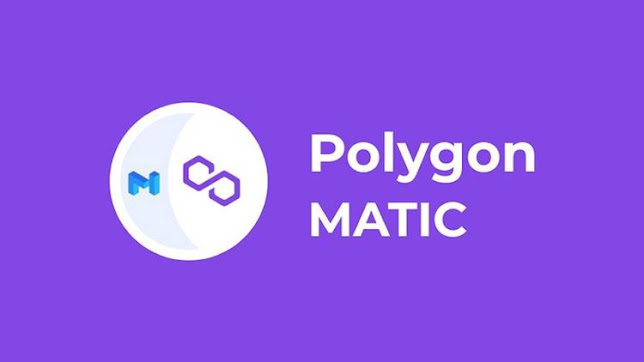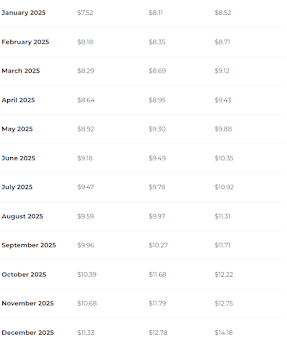The Polygon (MATIC) Coin current CoinMarketCap ranking is #18, with a live market cap of $11,016,051,118 USD. It has a circulating supply of 7,808,492,081 MATIC coins and a max. supply of 10,000,000,000 MATIC crypto coins.
MATIC Price Live Data
The live Polygon price today is $1.39 USD with a 24-hour trading volume of $665,771,954 USD. We update our MATIC to USD price in real-time. Polygon is down 2.46% in the last 24 hours. The current CoinMarketCap ranking is #17, with a live market cap of $10,888,648,177 USD. It has a circulating supply of 7,808,492,081 MATIC coins and a max. supply of 10,000,000,000 MATIC coins.
Polygon (MATIC) Coin Price Prediction For 2022
Polygon (MATIC) Price Prediction 2022
According to our deep technical analysis on past price data of MATIC, In 2022 the price of Polygon is predicted to reach at a minimum level of $1.95. The MATIC price can reach a maximum level of $2.27 with the average trading price of $2.01.
Polygon (MATIC) Price Prediction 2023
MATIC Most crypto experts are confident that MATIC could rise in the long-term perspective since there is still optimism that it will attract more attention from investors. For 2023, an average rate of $5.68 and a minimum of $5.29 are projected. The coin’s maximum trading value is expected to be around $6.51 at the end of 2023.
Polygon (MATIC) Price Prediction 2024
Polygon price prediction would start the year 2024 with an average price of $4.9; Polygon matic price would be around $5.3 in 2024. In the last 30 days of the year 2024, the Polygon price prediction would reach to $6.
Polygon (MATIC) Price Prediction 2025
MATIC price would be $5.7 in the year 2025. The minimum prediction Polygon price is $5.2 and maximum predicted is $6.1. Our Polygon Price Prediction suggests the possibility that MATIC’s average price might be around $4.74 by the middle of 2025, and if the coin attracts more investors, crypto might climb to $5.06 by the year-end. The expected growth of MATIC is 117%.
WalletInvestor
According to the forecast by the WalletInvestor crypto analytical source, the value of the Polygon cryptocurrency may strive to overcome the $3.38 mark in the middle of 2022. It is expected that by the end of July, the Polygon exchange rate could be fixed at $3.47. By the end of 2022, the coin’s lowest price might be $2.87, and the maximum value might touch the $4.57 level.
Government Capital
Government Capital appears to be confident that MATIC could continue to grow well beyond 2022. According to the source’s analysts, Polygon might be trading over $4 per coin by 2023.
TradingBeasts
According to TradingBeasts’ technical analysis, MATIC may break the $3 mark in 2022 before continuing its upward trend. MATIC’s average exchange rate might touch the $5 level by the end of the year.
GOV Capital’s
As per our data, opinions expressed includes the asset Polygon price has been in an uptrend for the past 1 year. Polygon Price Prediction has been showing a rising tendency so we believe that similar market cap segments were very popular in the given time high frame. Future Polygon price prediction is $3.764 (82.673% ) after one year. GOV Capital’s Polygon MATIC price prediction.
Reddit Users
The biggest landmark victory for MATIC is that it would cross $1 and calculating ROI percentage will be around 44818%, so with five years HODL, it will be worth betting on Polygon Price Prediction. With an increased risk of loss, we would recommend MATIC to be a reasonably good investment advice though.
What Is Polygon (MATIC)?
Polygon (previously Matic Network) is the first well-structured, easy-to-use platform for Ethereum scaling and infrastructure development. Its core component is Polygon SDK, a modular, flexible framework that supports building multiple types of applications.
To learn more about this project, check out our deep dive of Polygon Matic.
Using Polygon, one can create optimistic rollup chains, ZK rollup chains, stand alone chains or any other kind of infra required by the developer.
Polygon effectively transforms Ethereum into a full-fledged multi-chain system (aka Internet of Blockchains). This multi-chain system is akin to other ones such as Polkadot, Cosmos, Avalanche etc. with the advantages of Ethereum’s security, vibrant ecosystem and openness.
The $MATIC token will continue to exist and will play an increasingly important role, securing the system and enabling governance.
Polygon (formerly Matic Network) is a Layer 2 scaling solution backed by Binance and Coinbase. The project seeks to stimulate mass adoption of cryptocurrencies by resolving the problems of scalability on many blockchains.
Polygon combines the Plasma Framework and the proof-of-stake blockchain architecture. The Plasma framework used by Polygon as proposed by the co-founder of Ethereum, Vitalik Buterin, allows for the easy execution of scalable and autonomous smart contracts.
Nothing will change for the existing ecosystem built on the Plasma-POS chain. With Polygon, new features are being built around the existing proven technology to expand the ability to cater to diverse needs from the developer ecosystem. Polygon will continue to develop the core technology so that it can scale to a larger ecosystem.
Polygon boasts of up to 65,000 transactions per second on a single side chain, along with a respectable block confirmation time of less than two seconds. The framework also allows for the creation of globally available decentralized financial applications on a single foundational blockchain.
The Plasma framework gives Polygon the potential of housing an unlimited number of decentralized applications on their infrastructure without experiencing the normal drawbacks common on proof-of-work blockchains. So far, Polygon has attracted more than 50 DApps to its PoS-secured Ethereum sidechain.
MATIC, the native tokens of Polygon, is an ERC-20 token running on the Ethereum blockchain. The tokens are used for payment services on Polygon and as a settlement currency between users who operate within the Polygon ecosystem. The transaction fees on Polygon sidechains are also paid in MATIC tokens.
Who Are the Founders of Polygon?
Polygon (formerly Matic Network) was launched in October 2017. Polygon was co-founded by Jaynti Kanani, Sandeep Nailwal and Anurag Arjun, two experienced blockchain developers and a business consultant.
Before moving to its network in 2019, the Polygon team was a huge contributor in the Ethereum ecosystem. The team worked on implementing the Plasma MVP, the WalletConnect protocol and the widely-used Dagger event notification engine on Ethereum.
The team included co-founder of Polygon, Jaynti Kanani. Jaynti, a full-stack developer and blockchain engineer currently serves as the CEO of Polygon.
Jaynti played an integral role in implementing Web3, Plasma and the WalletConnect protocol on Ethereum. Prior to his blockchain involvement, Jaynti worked as a data scientist with Housing.com.
Co-founder and chief operations officer of Polygon, Sandeep Nailwal is a blockchain programmer and entrepreneur. Before jointly starting Polygon (formerly Matic), Sandeep had served as the CEO of Scopeweaver, and the chief technical officer of Welspun Group.
Anurag Arjun is the only non-programming co-founder of Polygon. As a product manager, he has had stints with IRIS Business, SNL Financial, Dexter Consultancy and Cognizant Technologies.
What Makes Polygon Unique?
Polygon is self-described as a Layer 2 scaling solution, which means that the project doesn’t seek to upgrade its current basic blockchain layer any time soon. The project focuses on reducing the complexity of scalability and instant blockchain transactions.
Polygon uses a customized version of the Plasma framework which is built on proof-of-stake checkpoints that run through the Ethereum main-chain. This unique technology allows each sidechain on Polygon to achieve up to 65,536 transactions per block.
Commercially, the sidechains of Polygon are structurally designed to support a variety of decentralized finance (DeFi) protocols available in the Ethereum ecosystem.
While Polygon currently supports only Ethereum basechain, the network intends to extend support for additional basechains, based on community suggestions and consensus. This would makePolygon an interoperable decentralized Layer 2 blockchain platform
Polygon (MATIC) London Hard Fork and EIP-1559 Upgrade
Polygon announced the much-anticipated London Hard Fork and Ethereum Improvement Proposal (EIP) 1559 upgrade will go live on the mainnet on Jan. 18, 2022. The upgrade will completely change the way the fee mechanism works on the Ethereum network — it eliminates first-price auction as the main fee calculation mechanism and instead uses a base fee that is burned, instead of sent to miners. Although it does not lower transaction fees, it makes it more stable, allowing users to estimate costs better and reduce overpayment.
However, as MATIC tokens are burned as base fees — and MATIC has a fixed supply of 10 billion tokens — it will have a deflationary effect on the digital asset. Polygon’s core team projected an annual burn of MATIC amounting to 0.27% of the token’s total supply — around 27 million tokens. This deflationary pressure will most likely benefit validators and delegators the most, as rewards for processing transactions on Polygon are denominated in MATIC. Furthermore, base fee will increase automatically once the block is filled up, resulting in fewer spam transactions and less network congestion. Ethereum mainnet’s London Hard Fork went live on Aug. 5, 2021.
How Is the Polygon Secured?
As a Layer 2 solution utilizing a network of proof-of-stake validators for asset security, staking is an integral part of the Polygon ecosystem. Validators on the network will stake their MATIC tokens as collateral to become part of the network’s PoS consensus mechanism and will receive MATIC tokens in return.
Members of the network who do not wish to become validators can delegate their MATIC tokens to another validator, but will still take part in their staking process and earn staking rewards.
In addition to the proof-of-stake checkpointing, Polygon uses block producers at the block producer layer to achieve a higher degree of decentralization. These block producers give finality to the main chains using checkpoints and fraud-proof mechanisms.
Tags:
prediction





